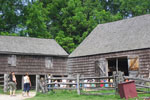Old Bethpage Village
In 1695, Thomas Powell bought about 10,000 acres from local Indian tribes, including the Marsapeque, Matinecoc, and Sacatogue, for 140 English pounds. This land, which includes present day Bethpage, East Farmingdale, Farmingdale, Old Bethpage, Plainedge, Plainview, South Farmingdale, and part of Melville, is known as the Bethpage Purchase and is approximately 3.5 miles east to west and 5 miles north to south.
Powell called his land Bethphage, because it was situated between two other places on Long Island, Jericho and Jerusalem, just as the biblical town of Bethphage (meaning “house of figs”) was situated between Jericho and Jerusalem in Israel. Today, the Long Island place formerly called Jerusalem is known as Wantagh and Island Trees, while the placename Jericho is unaltered. Over time, Bethpage was spelled without the second “H”. Powell’s 14 children split up his purchase and it evolved into several farming communities, and the one in this mostly central part of the purchase retained the name “Bethpage”.
A railroad spur completed in 1873, known as the Bethpage Branch of the Central Railroad of Long Island, ran to a brickworks plant which had opened in Old Bethpage in the 1860s. The railway was built to transport bricks for the construction of Alexander Stewart’s Garden City. For a few years, regularly-scheduled passenger traffic also appeared in timetables, with the station being called Bethpage. The line was abandoned in 1942. Remnants of a locomotive turntable can be found in the woods of Bethpage State Park on the east side of Round Swamp Road.[4][5]
In 1908, William Kissam Vanderbilt II began construction of the Long Island Motor Parkway, one of the country’s first highways. Eventually stretching 45 miles from Queens, New York to Lake Ronkonkoma, New York, a portion of the parkway ran through Old Bethpage. Street names such as “Vanderbilt Lane”, “Motor Parkway” and “Toll Place” serve as reminders. Segments of the old roadbed and some bridges can still be seen in some places, including Battle Row Campground, Bethpage State Park, and the Old Bethpage Village Restoration.
In 1932, under the auspices of Long Island State Parks Commissioner, Robert Moses, Bethpage State Park, was opened. The park and its 1,400 acres is almost entirely within the hamlet of Old Bethpage. In 1936, the adjacent hamlet of Central Park changed its name to Bethpage. Following this name change, the hamlet originally called Bethpage resisted suggestions that it merge with the new Bethpage, and got approval from the post office to change its name to Old Bethpage, though it did not have its own post office until 1965. Bethpage State Park remained so named, leading some to mistakenly believe that the park is located mostly in Bethpage.
Old Bethpage has a number of community parks tucked in between its homes. For residents, the primary park is the Old Bethpage Park, located on Haypath Road. This park features two tennis courts, baseball and softball fields, a basketball court, playgrounds and a community center. For out-of-towners, the town is also home to the Battle Row Campground, which provides accommodations for trailers and tent camping on its 44 acres
